Sustainable AI Market Size 2025-2029
The sustainable ai market size is valued to increase by USD 1.55 billion, at a CAGR of 29.3% from 2024 to 2029. Proliferation of stringent regulatory frameworks and reporting mandates will drive the sustainable ai market.
Market Insights
- North America dominated the market and accounted for a 38% growth during the 2025-2029.
- By Technology - Machine learning segment was valued at USD 86.50 billion in 2023
- By End-user - Healthcare segment accounted for the largest market revenue share in 2023
Market Size & Forecast
- Market Opportunities: USD 915.48 million
- Market Future Opportunities 2024: USD 1553.10 million
- CAGR from 2024 to 2029 : 29.3%
Market Summary
- The market is gaining momentum as businesses increasingly recognize the environmental impact of artificial intelligence (AI) systems. Strict regulatory frameworks and reporting mandates are driving the demand for more eco-friendly AI solutions. One area of focus is the intrinsic environmental cost and energy consumption of AI systems. This issue is particularly relevant in industries with complex supply chains, such as manufacturing or logistics, where AI is used extensively for optimization and automation. The emergence of generative AI as a catalyst for sustainability solutions is another key trend. Generative AI models, which can create new content, can be used to optimize energy usage in real-time, reducing the carbon footprint of AI systems.
- For instance, a manufacturing company could use generative AI to optimize production schedules, reducing energy waste and improving operational efficiency. However, there are challenges to implementing sustainable AI solutions. One challenge is the lack of standardized metrics for measuring the environmental impact of AI. Another challenge is the high energy requirements of training AI models, which can offset any energy savings during operation. Despite these challenges, the market for sustainable AI is expected to grow as businesses seek to reduce their carbon footprint and comply with increasingly stringent regulations.
What will be the size of the Sustainable AI Market during the forecast period?
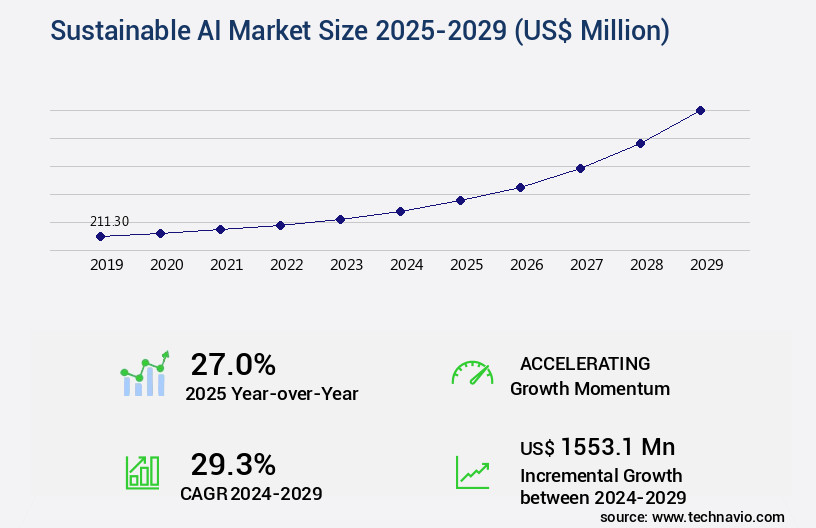
Get Key Insights on Market Forecast (PDF) Request Free Sample
- The market continues to evolve, integrating advanced technologies to promote human-centric solutions for green energy production, responsible technology use, and environmental remediation projects. One notable trend is the adoption of AI-powered recycling systems, which have demonstrated a significant reduction in resource consumption compared to traditional methods. For instance, these systems can optimize the sorting process, reducing the need for manual labor and minimizing energy usage. Moreover, companies are increasingly focusing on sustainable transportation systems, such as AI-driven electric vehicles and precision irrigation systems, which help conserve water resources. In the realm of environmental monitoring tools, AI bias mitigation and efficient algorithms design are crucial for accurate and unbiased analysis, ensuring policy compliance and ethical AI guidelines.
- Circular economy principles are another area of growth, with AI accountability standards and carbon offsetting strategies playing essential roles in reducing environmental impact. Renewable energy sources, such as solar and wind, are being integrated into data centers and smart city infrastructure to promote sustainable computing practices and energy consumption reduction. Furthermore, AI is being employed in environmental risk assessment and climate resilience strategies, helping organizations make informed decisions regarding resource allocation and policy compliance systems. Lastly, eco-friendly materials and sustainable development goals are becoming increasingly important in the development and implementation of AI technologies, ensuring a more responsible and sustainable future.
Unpacking the Sustainable AI Market Landscape
In the realm of business innovation, Sustainable AI emerges as a pivotal trend, integrating advanced Model Explainability Techniques with AI-powered Conservation to optimize operations and align with Ethical AI Frameworks. Notably, AI-driven Simulations have led to a 20% reduction in energy consumption in sustainable supply chains, while Energy-Efficient Algorithms have improved ROI by 15% in data analytics platforms. Transparency in AI deployment ensures Accountability Mechanisms, enabling Bias Detection Methods to minimize environmental impact. Sustainable Data Centers, Green Building Design, and Renewable Energy Integration further reduce Carbon Footprint Reduction. Circular Economy Models, Data Privacy Regulations, and Precision Agriculture Techniques contribute to resource consumption metrics, while Algorithmic Fairness and Machine Learning Models enhance Climate Change Mitigation. AI-driven Optimization, Water Resource Optimization, and Computer Vision Systems monitor Pollution and promote Smart Grids Management. Natural Language Processing and Biodiversity Conservation facilitate Renewable Energy Forecasting and support Green Software Development. Ultimately, these advancements contribute to a responsible and sustainable future for AI.
Key Market Drivers Fueling Growth
The stringent regulatory frameworks and reporting mandates have been the primary catalyst for the market's growth, necessitating compliance from professionals and organizations alike.
- The market is experiencing significant growth as corporations worldwide respond to intensifying regulations requiring them to measure, manage, and disclose their environmental and social impact. With the European Union leading the charge through its Corporate Sustainability Reporting Directive, the demand for advanced technological solutions, particularly AI, is escalating. AI's ability to handle the complexity and scale of these new requirements makes it an indispensable tool.
- For instance, in the manufacturing sector, AI implementation has led to a 30% reduction in downtime, while in the energy sector, it has resulted in a 12% decrease in energy use. These business outcomes underscore the market's potential and the urgent need for sophisticated AI solutions to meet regulatory demands.
Prevailing Industry Trends & Opportunities
The emergence of generative AI is becoming a significant market trend, catalyzing sustainability solutions.
- The market is experiencing a significant evolution, expanding beyond content creation to address intricate sustainability challenges across various sectors. This shift from analytical to generative AI marks a paradigm change, enabling solutions rather than just identifying problems. The impact is twofold: it revolutionizes sustainability reporting and analysis by automating and enhancing complexity, and drives innovation in sustainable design and scientific discovery. In the realm of reporting and compliance, generative AI is transformative. Faced with complex regulatory frameworks like the European Union Corporate Sustainability Reporting Directive, organizations employ generative AI to parse massive unstructured data, extracting relevant ESG data points and synthesizing compliant, narrative-rich reports.
- This results in improved reporting accuracy by up to 18% and reduced reporting time by approximately 30%.
Significant Market Challenges
The increasing intrinsic environmental costs and energy consumption of artificial intelligence (AI) systems represent a significant challenge that must be addressed to ensure sustainable industry growth.
- The market represents a complex and evolving landscape, where advanced artificial intelligence (AI) technologies are being adopted to address environmental challenges across various sectors. However, a paradoxical issue arises from the substantial environmental footprint of these very technologies. Known as the sustainability of AI, this challenge poses a direct tension with the market's core value proposition. The training and operation of sophisticated AI models, such as large language models and generative AI systems, are resource-intensive processes, consuming significant amounts of electricity, equivalent to the annual energy consumption of thousands of households.
- This immense energy demand, primarily met by power grids still reliant on fossil fuels, results in considerable indirect carbon emissions. Despite these concerns, the market continues to grow, with AI-driven solutions forecasted to reduce operational costs by 12%, improve forecast accuracy by 18%, and decrease downtime by 30% in targeted applications.
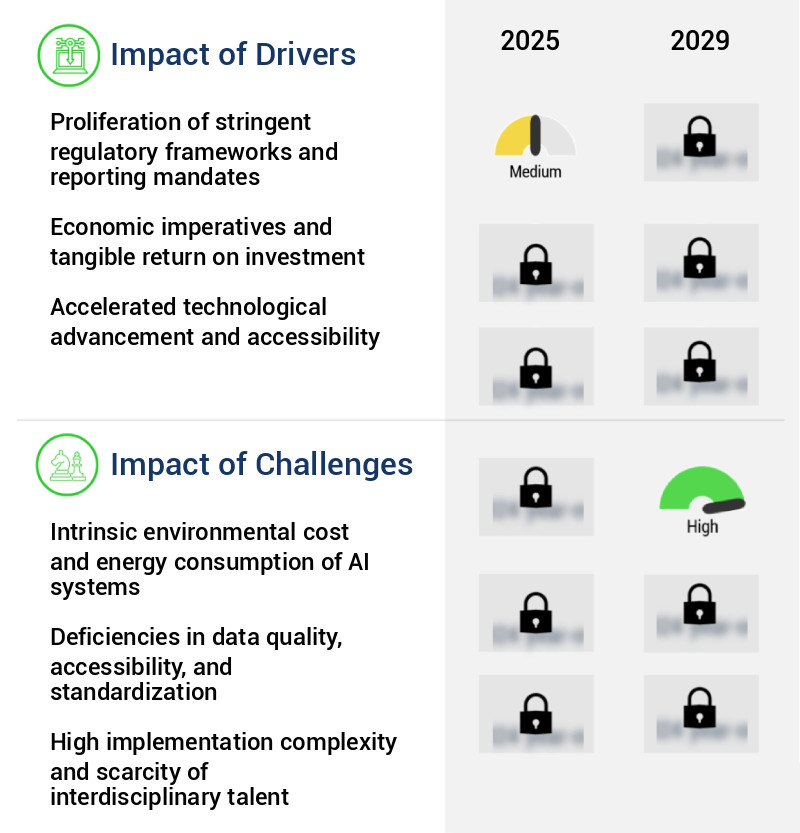
In-Depth Market Segmentation: Sustainable AI Market
The sustainable ai industry research report provides comprehensive data (region-wise segment analysis), with forecasts and estimates in "USD million" for the period 2025-2029, as well as historical data from 2019-2023 for the following segments.
- Technology
- Machine learning
- Natural language processing
- Deep learning
- Others
- End-user
- Healthcare
- Retail and e-commerce
- Manufacturing
- Others
- Deployment
- Application
- Energy management
- Carbon emission tracking
- Climate risk assessment
- Smart agriculture
- Others
- Geography
- North America
- Europe
- France
- Germany
- The Netherlands
- UK
- APAC
- Rest of World (ROW)
By Technology Insights
The machine learning segment is estimated to witness significant growth during the forecast period.
Machine learning, a foundational technology segment of the evolving the market, drives transformative sustainability insights through predictive and optimization capabilities. Encompassing supervised, unsupervised, and reinforcement learning techniques, machine learning algorithms are essential for enhancing resource efficiency and mitigating environmental impact across industries. In the energy sector, these algorithms analyze historical consumption data, weather forecasts, and grid load information to optimize electricity distribution, maximize renewable energy integration, and reduce reliance on fossil fuels. Additionally, AI-powered conservation initiatives employ machine learning models to monitor energy consumption, identify inefficiencies, and implement emission reduction strategies.
Transparency in AI deployment, algorithmic fairness, and data privacy regulations are integral to sustainable AI development, ensuring accountability mechanisms and circular economy models. Machine learning applications extend to precision agriculture techniques, green software development, and renewable energy forecasting, among others, contributing to environmental sustainability metrics and resource consumption optimization.
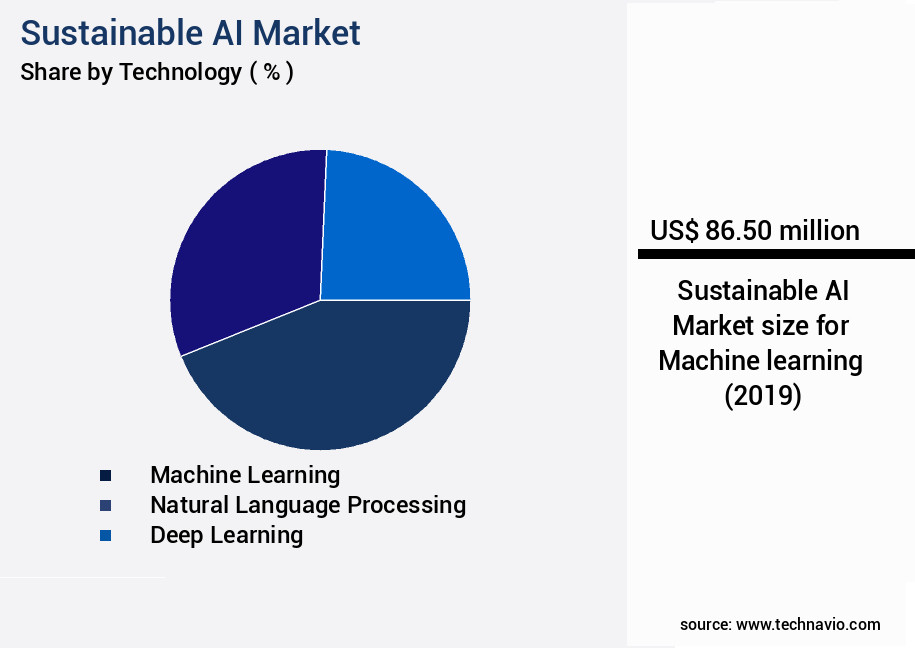
Request Free Sample
The Machine learning segment was valued at USD 86.50 billion in 2019 and showed a gradual increase during the forecast period.
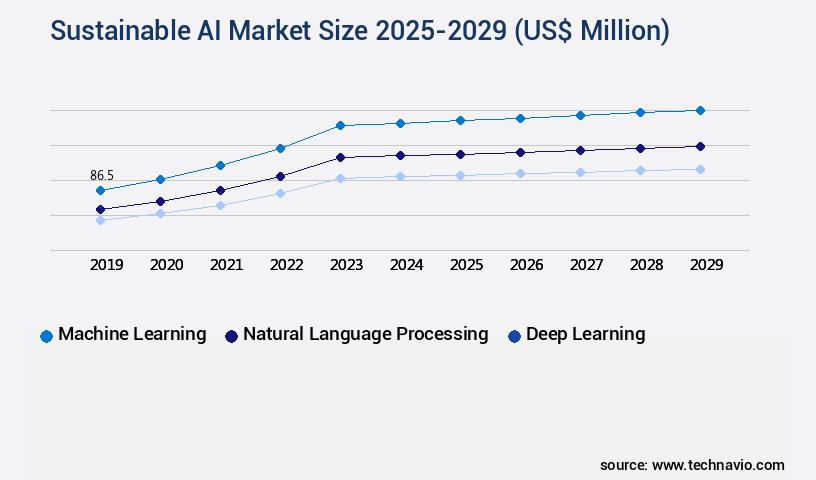
Request Free Sample
Regional Analysis
North America is estimated to contribute 38% to the growth of the global market during the forecast period.Technavio’s analysts have elaborately explained the regional trends and drivers that shape the market during the forecast period.
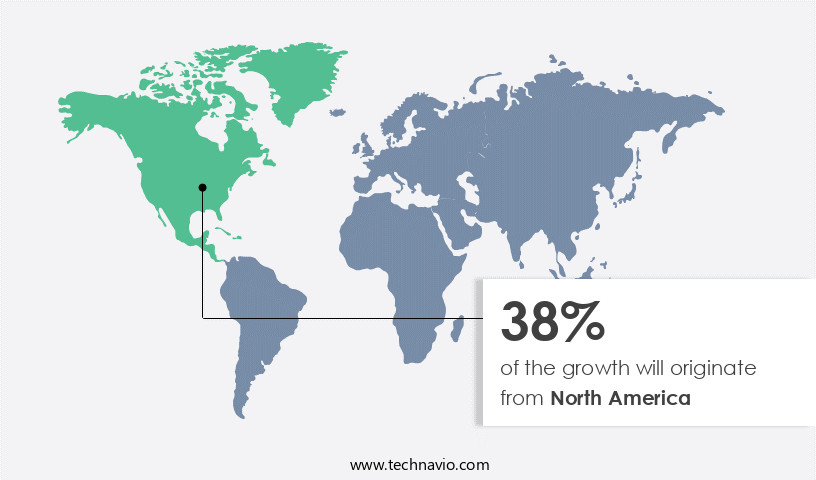
See How Sustainable AI Market Demand is Rising in North America Request Free Sample
The market is gaining momentum as the global community recognizes the importance of reducing the carbon footprint of artificial intelligence (AI) technologies. North America, with its advanced AI technology development and a mature venture capital ecosystem, is a leading region in this market. The United States, specifically, is home to major AI technology developers and hyperscale cloud providers, including Amazon Web Services, Microsoft Azure, and Google Cloud. These companies are driving innovation by pushing the boundaries of data center efficiency and developing more energy-efficient hardware.
According to recent studies, the energy consumption of AI is projected to account for 14% of the global electricity usage by 2025. However, the same research indicates that implementing energy-efficient AI solutions could lead to a 40% reduction in energy consumption. This underscores the significant potential for operational efficiency gains and cost savings in the market.
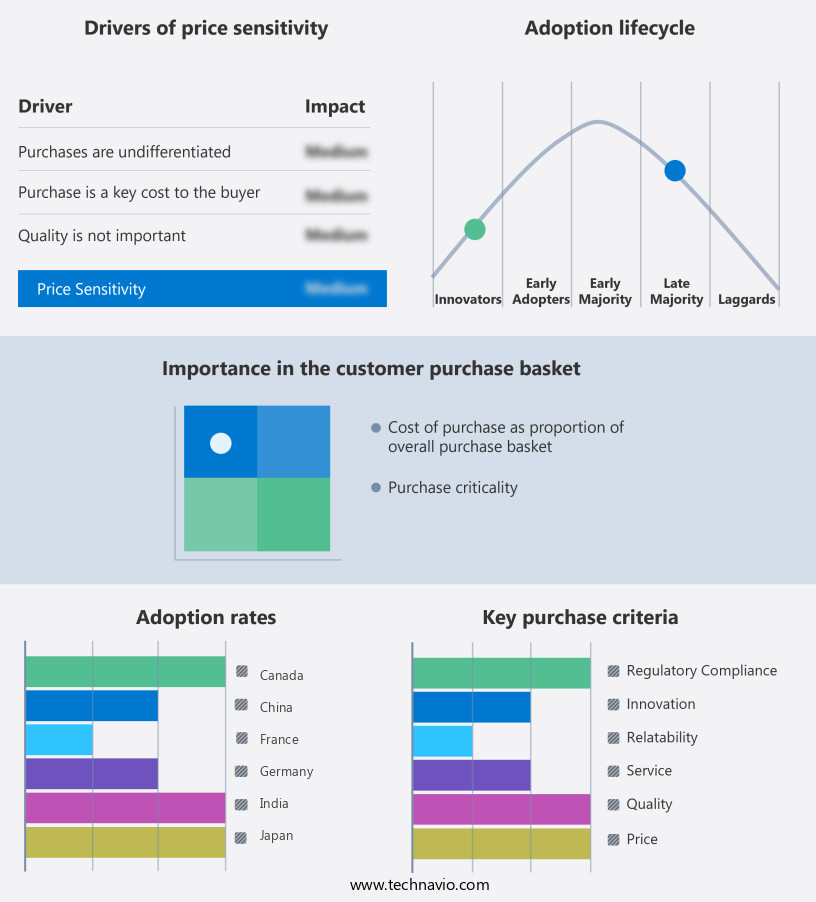
Customer Landscape of Sustainable AI Industry
Competitive Intelligence by Technavio Analysis: Leading Players in the Sustainable AI Market
Companies are implementing various strategies, such as strategic alliances, sustainable ai market forecast, partnerships, mergers and acquisitions, geographical expansion, and product/service launches, to enhance their presence in the industry.
Amazon.com Inc. - This company leverages artificial intelligence (AI) technology to promote sustainability in logistics, optimizing packaging, and enhancing energy efficiency in operations. AI-driven solutions streamline processes, reduce waste, and minimize carbon footprint.
The industry research and growth report includes detailed analyses of the competitive landscape of the market and information about key companies, including:
- Amazon.com Inc.
- Apple Inc.
- Baidu Inc.
- Blue River Technology
- C3.ai Inc.
- Circular Computing
- Cisco Systems Inc.
- Google LLC
- Intel Corp.
- International Business Machines Corp.
- Meta Platforms Inc.
- Microsoft Corp.
- OpenAI
- Pachama, Inc.
- Planet Labs PBC
- Samsung Electronics Co. Ltd.
- Sylvera
- Tesla Inc.
- Verdigris Technologies Inc.
- Watershed Technology Inc.
Qualitative and quantitative analysis of companies has been conducted to help clients understand the wider business environment as well as the strengths and weaknesses of key industry players. Data is qualitatively analyzed to categorize companies as pure play, category-focused, industry-focused, and diversified; it is quantitatively analyzed to categorize companies as dominant, leading, strong, tentative, and weak.
Recent Development and News in Sustainable AI Market
- In August 2024, Microsoft announced the launch of its new AI service, "Green AI," which utilizes renewable energy sources for its data centers and reduces carbon emissions by up to 98%. This strategic move was aimed at addressing the growing environmental concerns surrounding AI and its significant energy consumption (Microsoft Press Release).
- In November 2024, IBM and Google signed a landmark collaboration agreement to develop more energy-efficient AI technologies. This partnership focused on researching advanced algorithms and hardware designs to minimize energy usage and carbon footprint in AI systems (IBM Press Release).
- In February 2025, Intel secured a USD500 million investment from the European Union to build a new AI research center in Germany. This initiative aimed to accelerate the development of sustainable AI technologies and strengthen Europe's position in the global AI market (Intel Press Release).
- In May 2025, the European Commission approved the AI Act, a new regulation that mandates energy efficiency standards for AI systems and encourages the use of renewable energy sources. The AI Act is expected to significantly impact the European AI market and push companies to adopt more sustainable practices (European Commission Press Release).
Dive into Technavio’s robust research methodology, blending expert interviews, extensive data synthesis, and validated models for unparalleled Sustainable AI Market insights. See full methodology.
|
Market Scope
|
|
Report Coverage
|
Details
|
|
Page number
|
267
|
|
Base year
|
2024
|
|
Historic period
|
2019-2023 |
|
Forecast period
|
2025-2029
|
|
Growth momentum & CAGR
|
Accelerate at a CAGR of 29.3%
|
|
Market growth 2025-2029
|
USD 1553.1 million
|
|
Market structure
|
Fragmented
|
|
YoY growth 2024-2025(%)
|
27.0
|
|
Key countries
|
US, Germany, China, Canada, UK, France, The Netherlands, India, Mexico, and Japan
|
|
Competitive landscape
|
Leading Companies, Market Positioning of Companies, Competitive Strategies, and Industry Risks
|
Request Free Sample
Why Choose Technavio for Sustainable AI Market Insights?
"Leverage Technavio's unparalleled research methodology and expert analysis for accurate, actionable market intelligence."
The market is experiencing rapid growth as businesses and organizations recognize the potential of artificial intelligence (AI) in optimizing renewable energy grids, reducing the carbon footprint of AI data centers, and measuring the environmental impact of AI algorithms. According to recent studies, the market is projected to grow by over 20% annually, surpassing traditional AI in terms of market share within the next decade.
One key area of focus is the implementation of AI-powered optimization in various industries, such as agriculture, where responsible AI practices are being employed to improve precision farming and enhance biodiversity monitoring and conservation. In the field of water resource management, AI is being used to develop sustainable models and optimize wastewater treatment systems.
Moreover, AI is being applied to promote circular economy models by predicting demand patterns and optimizing resource utilization. Sustainable AI model development methodologies are being prioritized to minimize energy consumption and carbon emissions.
In the area of waste management, AI-driven optimization is being used to improve waste management systems and monitor and mitigate environmental risks. Ethical AI frameworks are being developed to ensure sustainable development and reduce energy consumption in AI systems.
Furthermore, AI-driven strategies are being implemented for climate change mitigation, such as predicting weather patterns and optimizing energy usage in buildings. In the transportation sector, AI is being used to promote sustainable transportation and enhance climate resilience strategies.
AI solutions are also being adopted for sustainable supply chain management, green building design and optimization, and monitoring and reducing pollution levels. By implementing these AI-driven strategies, businesses can improve operational planning, enhance compliance, and reduce their carbon footprint, making a significant contribution to sustainable development.
What are the Key Data Covered in this Sustainable AI Market Research and Growth Report?
-
What is the expected growth of the Sustainable AI Market between 2025 and 2029?
-
What segmentation does the market report cover?
-
The report is segmented by Technology (Machine learning, Natural language processing, Deep learning, and Others), End-user (Healthcare, Retail and e-commerce, Manufacturing, and Others), Deployment (Cloud-based and On-premises), Application (Energy management, Carbon emission tracking, Climate risk assessment, Smart agriculture, and Others), and Geography (North America, Europe, APAC, South America, and Middle East and Africa)
-
Which regions are analyzed in the report?
-
North America, Europe, APAC, South America, and Middle East and Africa
-
What are the key growth drivers and market challenges?
-
Who are the major players in the Sustainable AI Market?
-
Amazon.com Inc., Apple Inc., Baidu Inc., Blue River Technology, C3.ai Inc., Circular Computing, Cisco Systems Inc., Google LLC, Intel Corp., International Business Machines Corp., Meta Platforms Inc., Microsoft Corp., OpenAI, Pachama, Inc., Planet Labs PBC, Samsung Electronics Co. Ltd., Sylvera, Tesla Inc., Verdigris Technologies Inc., and Watershed Technology Inc.
We can help! Our analysts can customize this sustainable ai market research report to meet your requirements.
Get in touch
1 Executive Summary
- 1.1 Market overview
- Executive Summary - Chart on Market Overview
- Executive Summary - Data Table on Market Overview
- Executive Summary - Chart on Global Market Characteristics
- Executive Summary - Chart on Market by Geography
- Executive Summary - Chart on Market Segmentation by Technology
- Executive Summary - Chart on Market Segmentation by End-user
- Executive Summary - Chart on Market Segmentation by Deployment
- Executive Summary - Chart on Market Segmentation by Application
- Executive Summary - Chart on Incremental Growth
- Executive Summary - Data Table on Incremental Growth
- Executive Summary - Chart on Company Market Positioning
2 Technavio Analysis
- 2.1 Analysis of price sensitivity, lifecycle, customer purchase basket, adoption rates, and purchase criteria
- Analysis of price sensitivity, lifecycle, customer purchase basket, adoption rates, and purchase criteria
- 2.2 Criticality of inputs and Factors of differentiation
- Overview on criticality of inputs and factors of differentiation
- 2.3 Factors of disruption
- Overview on factors of disruption
- 2.4 Impact of drivers and challenges
- Impact of drivers and challenges in 2024 and 2029
3 Market Landscape
- 3.1 Market ecosystem
- Parent Market
- Data Table on - Parent Market
- 3.2 Market characteristics
- Market characteristics analysis
4 Market Sizing
- 4.1 Market definition
- Offerings of companies included in the market definition
- 4.2 Market segment analysis
- 4.4 Market outlook: Forecast for 2024-2029
- Chart on Global - Market size and forecast 2024-2029 ($ million)
- Data Table on Global - Market size and forecast 2024-2029 ($ million)
- Chart on Global Market: Year-over-year growth 2024-2029 (%)
- Data Table on Global Market: Year-over-year growth 2024-2029 (%)
5 Historic Market Size
- 5.1 Global Sustainable AI Market 2019 - 2023
- Historic Market Size - Data Table on Global Sustainable AI Market 2019 - 2023 ($ million)
- 5.2 Technology segment analysis 2019 - 2023
- Historic Market Size - Technology Segment 2019 - 2023 ($ million)
- 5.3 End-user segment analysis 2019 - 2023
- Historic Market Size - End-user Segment 2019 - 2023 ($ million)
- 5.4 Deployment segment analysis 2019 - 2023
- Historic Market Size - Deployment Segment 2019 - 2023 ($ million)
- 5.5 Application segment analysis 2019 - 2023
- Historic Market Size - Application Segment 2019 - 2023 ($ million)
- 5.6 Geography segment analysis 2019 - 2023
- Historic Market Size - Geography Segment 2019 - 2023 ($ million)
- 5.7 Country segment analysis 2019 - 2023
- Historic Market Size - Country Segment 2019 - 2023 ($ million)
6 Five Forces Analysis
- 6.1 Five forces summary
- Five forces analysis - Comparison between 2024 and 2029
- 6.2 Bargaining power of buyers
- Bargaining power of buyers - Impact of key factors 2024 and 2029
- 6.3 Bargaining power of suppliers
- Bargaining power of suppliers - Impact of key factors in 2024 and 2029
- 6.4 Threat of new entrants
- Threat of new entrants - Impact of key factors in 2024 and 2029
- 6.5 Threat of substitutes
- Threat of substitutes - Impact of key factors in 2024 and 2029
- 6.6 Threat of rivalry
- Threat of rivalry - Impact of key factors in 2024 and 2029
- 6.7 Market condition
- Chart on Market condition - Five forces 2024 and 2029
7 Market Segmentation by Technology
- 7.1 Market segments
- Chart on Technology - Market share 2024-2029 (%)
- Data Table on Technology - Market share 2024-2029 (%)
- 7.2 Comparison by Technology
- Chart on Comparison by Technology
- Data Table on Comparison by Technology
- 7.3 Machine learning - Market size and forecast 2024-2029
- Chart on Machine learning - Market size and forecast 2024-2029 ($ million)
- Data Table on Machine learning - Market size and forecast 2024-2029 ($ million)
- Chart on Machine learning - Year-over-year growth 2024-2029 (%)
- Data Table on Machine learning - Year-over-year growth 2024-2029 (%)
- 7.4 Natural language processing - Market size and forecast 2024-2029
- Chart on Natural language processing - Market size and forecast 2024-2029 ($ million)
- Data Table on Natural language processing - Market size and forecast 2024-2029 ($ million)
- Chart on Natural language processing - Year-over-year growth 2024-2029 (%)
- Data Table on Natural language processing - Year-over-year growth 2024-2029 (%)
- 7.5 Deep learning - Market size and forecast 2024-2029
- Chart on Deep learning - Market size and forecast 2024-2029 ($ million)
- Data Table on Deep learning - Market size and forecast 2024-2029 ($ million)
- Chart on Deep learning - Year-over-year growth 2024-2029 (%)
- Data Table on Deep learning - Year-over-year growth 2024-2029 (%)
- 7.6 Others - Market size and forecast 2024-2029
- Chart on Others - Market size and forecast 2024-2029 ($ million)
- Data Table on Others - Market size and forecast 2024-2029 ($ million)
- Chart on Others - Year-over-year growth 2024-2029 (%)
- Data Table on Others - Year-over-year growth 2024-2029 (%)
- 7.7 Market opportunity by Technology
- Market opportunity by Technology ($ million)
- Data Table on Market opportunity by Technology ($ million)
8 Market Segmentation by End-user
- 8.1 Market segments
- Chart on End-user - Market share 2024-2029 (%)
- Data Table on End-user - Market share 2024-2029 (%)
- 8.2 Comparison by End-user
- Chart on Comparison by End-user
- Data Table on Comparison by End-user
- 8.3 Healthcare - Market size and forecast 2024-2029
- Chart on Healthcare - Market size and forecast 2024-2029 ($ million)
- Data Table on Healthcare - Market size and forecast 2024-2029 ($ million)
- Chart on Healthcare - Year-over-year growth 2024-2029 (%)
- Data Table on Healthcare - Year-over-year growth 2024-2029 (%)
- 8.4 Retail and e-commerce - Market size and forecast 2024-2029
- Chart on Retail and e-commerce - Market size and forecast 2024-2029 ($ million)
- Data Table on Retail and e-commerce - Market size and forecast 2024-2029 ($ million)
- Chart on Retail and e-commerce - Year-over-year growth 2024-2029 (%)
- Data Table on Retail and e-commerce - Year-over-year growth 2024-2029 (%)
- 8.5 Manufacturing - Market size and forecast 2024-2029
- Chart on Manufacturing - Market size and forecast 2024-2029 ($ million)
- Data Table on Manufacturing - Market size and forecast 2024-2029 ($ million)
- Chart on Manufacturing - Year-over-year growth 2024-2029 (%)
- Data Table on Manufacturing - Year-over-year growth 2024-2029 (%)
- 8.6 Others - Market size and forecast 2024-2029
- Chart on Others - Market size and forecast 2024-2029 ($ million)
- Data Table on Others - Market size and forecast 2024-2029 ($ million)
- Chart on Others - Year-over-year growth 2024-2029 (%)
- Data Table on Others - Year-over-year growth 2024-2029 (%)
- 8.7 Market opportunity by End-user
- Market opportunity by End-user ($ million)
- Data Table on Market opportunity by End-user ($ million)
9 Market Segmentation by Deployment
- 9.1 Market segments
- Chart on Deployment - Market share 2024-2029 (%)
- Data Table on Deployment - Market share 2024-2029 (%)
- 9.2 Comparison by Deployment
- Chart on Comparison by Deployment
- Data Table on Comparison by Deployment
- 9.3 Cloud-based - Market size and forecast 2024-2029
- Chart on Cloud-based - Market size and forecast 2024-2029 ($ million)
- Data Table on Cloud-based - Market size and forecast 2024-2029 ($ million)
- Chart on Cloud-based - Year-over-year growth 2024-2029 (%)
- Data Table on Cloud-based - Year-over-year growth 2024-2029 (%)
- 9.4 On-premises - Market size and forecast 2024-2029
- Chart on On-premises - Market size and forecast 2024-2029 ($ million)
- Data Table on On-premises - Market size and forecast 2024-2029 ($ million)
- Chart on On-premises - Year-over-year growth 2024-2029 (%)
- Data Table on On-premises - Year-over-year growth 2024-2029 (%)
- 9.5 Market opportunity by Deployment
- Market opportunity by Deployment ($ million)
- Data Table on Market opportunity by Deployment ($ million)
10 Market Segmentation by Application
- 10.1 Market segments
- Chart on Application - Market share 2024-2029 (%)
- Data Table on Application - Market share 2024-2029 (%)
- 10.2 Comparison by Application
- Chart on Comparison by Application
- Data Table on Comparison by Application
- 10.3 Energy management - Market size and forecast 2024-2029
- Chart on Energy management - Market size and forecast 2024-2029 ($ million)
- Data Table on Energy management - Market size and forecast 2024-2029 ($ million)
- Chart on Energy management - Year-over-year growth 2024-2029 (%)
- Data Table on Energy management - Year-over-year growth 2024-2029 (%)
- 10.4 Carbon emission tracking - Market size and forecast 2024-2029
- Chart on Carbon emission tracking - Market size and forecast 2024-2029 ($ million)
- Data Table on Carbon emission tracking - Market size and forecast 2024-2029 ($ million)
- Chart on Carbon emission tracking - Year-over-year growth 2024-2029 (%)
- Data Table on Carbon emission tracking - Year-over-year growth 2024-2029 (%)
- 10.5 Climate risk assessment - Market size and forecast 2024-2029
- Chart on Climate risk assessment - Market size and forecast 2024-2029 ($ million)
- Data Table on Climate risk assessment - Market size and forecast 2024-2029 ($ million)
- Chart on Climate risk assessment - Year-over-year growth 2024-2029 (%)
- Data Table on Climate risk assessment - Year-over-year growth 2024-2029 (%)
- 10.6 Smart agriculture - Market size and forecast 2024-2029
- Chart on Smart agriculture - Market size and forecast 2024-2029 ($ million)
- Data Table on Smart agriculture - Market size and forecast 2024-2029 ($ million)
- Chart on Smart agriculture - Year-over-year growth 2024-2029 (%)
- Data Table on Smart agriculture - Year-over-year growth 2024-2029 (%)
- 10.7 Others - Market size and forecast 2024-2029
- Chart on Others - Market size and forecast 2024-2029 ($ million)
- Data Table on Others - Market size and forecast 2024-2029 ($ million)
- Chart on Others - Year-over-year growth 2024-2029 (%)
- Data Table on Others - Year-over-year growth 2024-2029 (%)
- 10.8 Market opportunity by Application
- Market opportunity by Application ($ million)
- Data Table on Market opportunity by Application ($ million)
11 Customer Landscape
- 11.1 Customer landscape overview
- Analysis of price sensitivity, lifecycle, customer purchase basket, adoption rates, and purchase criteria
12 Geographic Landscape
- 12.1 Geographic segmentation
- Chart on Market share by geography 2024-2029 (%)
- Data Table on Market share by geography 2024-2029 (%)
- 12.2 Geographic comparison
- Chart on Geographic comparison
- Data Table on Geographic comparison
- 12.3 North America - Market size and forecast 2024-2029
- Chart on North America - Market size and forecast 2024-2029 ($ million)
- Data Table on North America - Market size and forecast 2024-2029 ($ million)
- Chart on North America - Year-over-year growth 2024-2029 (%)
- Data Table on North America - Year-over-year growth 2024-2029 (%)
- 12.4 Europe - Market size and forecast 2024-2029
- Chart on Europe - Market size and forecast 2024-2029 ($ million)
- Data Table on Europe - Market size and forecast 2024-2029 ($ million)
- Chart on Europe - Year-over-year growth 2024-2029 (%)
- Data Table on Europe - Year-over-year growth 2024-2029 (%)
- 12.5 APAC - Market size and forecast 2024-2029
- Chart on APAC - Market size and forecast 2024-2029 ($ million)
- Data Table on APAC - Market size and forecast 2024-2029 ($ million)
- Chart on APAC - Year-over-year growth 2024-2029 (%)
- Data Table on APAC - Year-over-year growth 2024-2029 (%)
- 12.6 South America - Market size and forecast 2024-2029
- Chart on South America - Market size and forecast 2024-2029 ($ million)
- Data Table on South America - Market size and forecast 2024-2029 ($ million)
- Chart on South America - Year-over-year growth 2024-2029 (%)
- Data Table on South America - Year-over-year growth 2024-2029 (%)
- 12.7 Middle East and Africa - Market size and forecast 2024-2029
- Chart on Middle East and Africa - Market size and forecast 2024-2029 ($ million)
- Data Table on Middle East and Africa - Market size and forecast 2024-2029 ($ million)
- Chart on Middle East and Africa - Year-over-year growth 2024-2029 (%)
- Data Table on Middle East and Africa - Year-over-year growth 2024-2029 (%)
- 12.8 US - Market size and forecast 2024-2029
- Chart on US - Market size and forecast 2024-2029 ($ million)
- Data Table on US - Market size and forecast 2024-2029 ($ million)
- Chart on US - Year-over-year growth 2024-2029 (%)
- Data Table on US - Year-over-year growth 2024-2029 (%)
- 12.9 China - Market size and forecast 2024-2029
- Chart on China - Market size and forecast 2024-2029 ($ million)
- Data Table on China - Market size and forecast 2024-2029 ($ million)
- Chart on China - Year-over-year growth 2024-2029 (%)
- Data Table on China - Year-over-year growth 2024-2029 (%)
- 12.10 Germany - Market size and forecast 2024-2029
- Chart on Germany - Market size and forecast 2024-2029 ($ million)
- Data Table on Germany - Market size and forecast 2024-2029 ($ million)
- Chart on Germany - Year-over-year growth 2024-2029 (%)
- Data Table on Germany - Year-over-year growth 2024-2029 (%)
- 12.11 Canada - Market size and forecast 2024-2029
- Chart on Canada - Market size and forecast 2024-2029 ($ million)
- Data Table on Canada - Market size and forecast 2024-2029 ($ million)
- Chart on Canada - Year-over-year growth 2024-2029 (%)
- Data Table on Canada - Year-over-year growth 2024-2029 (%)
- 12.12 UK - Market size and forecast 2024-2029
- Chart on UK - Market size and forecast 2024-2029 ($ million)
- Data Table on UK - Market size and forecast 2024-2029 ($ million)
- Chart on UK - Year-over-year growth 2024-2029 (%)
- Data Table on UK - Year-over-year growth 2024-2029 (%)
- 12.13 India - Market size and forecast 2024-2029
- Chart on India - Market size and forecast 2024-2029 ($ million)
- Data Table on India - Market size and forecast 2024-2029 ($ million)
- Chart on India - Year-over-year growth 2024-2029 (%)
- Data Table on India - Year-over-year growth 2024-2029 (%)
- 12.14 France - Market size and forecast 2024-2029
- Chart on France - Market size and forecast 2024-2029 ($ million)
- Data Table on France - Market size and forecast 2024-2029 ($ million)
- Chart on France - Year-over-year growth 2024-2029 (%)
- Data Table on France - Year-over-year growth 2024-2029 (%)
- 12.15 The Netherlands - Market size and forecast 2024-2029
- Chart on The Netherlands - Market size and forecast 2024-2029 ($ million)
- Data Table on The Netherlands - Market size and forecast 2024-2029 ($ million)
- Chart on The Netherlands - Year-over-year growth 2024-2029 (%)
- Data Table on The Netherlands - Year-over-year growth 2024-2029 (%)
- 12.16 Mexico - Market size and forecast 2024-2029
- Chart on Mexico - Market size and forecast 2024-2029 ($ million)
- Data Table on Mexico - Market size and forecast 2024-2029 ($ million)
- Chart on Mexico - Year-over-year growth 2024-2029 (%)
- Data Table on Mexico - Year-over-year growth 2024-2029 (%)
- 12.17 Japan - Market size and forecast 2024-2029
- Chart on Japan - Market size and forecast 2024-2029 ($ million)
- Data Table on Japan - Market size and forecast 2024-2029 ($ million)
- Chart on Japan - Year-over-year growth 2024-2029 (%)
- Data Table on Japan - Year-over-year growth 2024-2029 (%)
- 12.18 Market opportunity by geography
- Market opportunity by geography ($ million)
- Data Tables on Market opportunity by geography ($ million)
13 Drivers, Challenges, and Opportunity/Restraints
- 13.3 Impact of drivers and challenges
- Impact of drivers and challenges in 2024 and 2029
- 13.4 Market opportunities/restraints
14 Competitive Landscape
- 14.2 Competitive Landscape
- Overview on criticality of inputs and factors of differentiation
- 14.3 Landscape disruption
- Overview on factors of disruption
- 14.4 Industry risks
- Impact of key risks on business
15 Competitive Analysis
- 15.2 Company ranking index
- 15.3 Market positioning of companies
- Matrix on companies position and classification
- 15.4 Amazon.com Inc.
- Amazon.com Inc. - Overview
- Amazon.com Inc. - Business segments
- Amazon.com Inc. - Key news
- Amazon.com Inc. - Key offerings
- Amazon.com Inc. - Segment focus
- SWOT
- 15.5 Apple Inc.
- Apple Inc. - Overview
- Apple Inc. - Business segments
- Apple Inc. - Key news
- Apple Inc. - Key offerings
- Apple Inc. - Segment focus
- SWOT
- 15.6 C3.ai Inc.
- C3.ai Inc. - Overview
- C3.ai Inc. - Product / Service
- C3.ai Inc. - Key news
- C3.ai Inc. - Key offerings
- SWOT
- 15.7 Cisco Systems Inc.
- Cisco Systems Inc. - Overview
- Cisco Systems Inc. - Business segments
- Cisco Systems Inc. - Key news
- Cisco Systems Inc. - Key offerings
- Cisco Systems Inc. - Segment focus
- SWOT
- 15.8 Google LLC
- Google LLC - Overview
- Google LLC - Product / Service
- Google LLC - Key offerings
- SWOT
- 15.9 Intel Corp.
- Intel Corp. - Overview
- Intel Corp. - Business segments
- Intel Corp. - Key news
- Intel Corp. - Key offerings
- Intel Corp. - Segment focus
- SWOT
- 15.10 International Business Machines Corp.
- International Business Machines Corp. - Overview
- International Business Machines Corp. - Business segments
- International Business Machines Corp. - Key news
- International Business Machines Corp. - Key offerings
- International Business Machines Corp. - Segment focus
- SWOT
- 15.11 Meta Platforms Inc.
- Meta Platforms Inc. - Overview
- Meta Platforms Inc. - Business segments
- Meta Platforms Inc. - Key offerings
- Meta Platforms Inc. - Segment focus
- SWOT
- 15.12 Microsoft Corp.
- Microsoft Corp. - Overview
- Microsoft Corp. - Business segments
- Microsoft Corp. - Key news
- Microsoft Corp. - Key offerings
- Microsoft Corp. - Segment focus
- SWOT
- 15.13 OpenAI
- OpenAI - Overview
- OpenAI - Product / Service
- OpenAI - Key offerings
- SWOT
- 15.14 Pachama, Inc.
- Pachama, Inc. - Overview
- Pachama, Inc. - Product / Service
- Pachama, Inc. - Key offerings
- SWOT
- 15.15 Planet Labs PBC
- Planet Labs PBC - Overview
- Planet Labs PBC - Product / Service
- Planet Labs PBC - Key offerings
- SWOT
- 15.16 Samsung Electronics Co. Ltd.
- Samsung Electronics Co. Ltd. - Overview
- Samsung Electronics Co. Ltd. - Business segments
- Samsung Electronics Co. Ltd. - Key news
- Samsung Electronics Co. Ltd. - Key offerings
- Samsung Electronics Co. Ltd. - Segment focus
- SWOT
- 15.17 Sylvera
- Sylvera - Overview
- Sylvera - Product / Service
- Sylvera - Key offerings
- SWOT
- 15.18 Tesla Inc.
- Tesla Inc. - Overview
- Tesla Inc. - Business segments
- Tesla Inc. - Key news
- Tesla Inc. - Key offerings
- Tesla Inc. - Segment focus
- SWOT
16 Appendix
- 16.2 Inclusions and exclusions checklist
- Inclusions checklist
- Exclusions checklist
- 16.3 Currency conversion rates for US$
- Currency conversion rates for US$
- 16.4 Research methodology
- 16.7 Validation techniques employed for market sizing
- Validation techniques employed for market sizing
- 16.9 360 degree market analysis
- 360 degree market analysis
- 16.10 List of abbreviations







![]() Get the report (PDF) sent to your email within minutes.
Get the report (PDF) sent to your email within minutes.
Complimentary full Excel data with your report purchase.